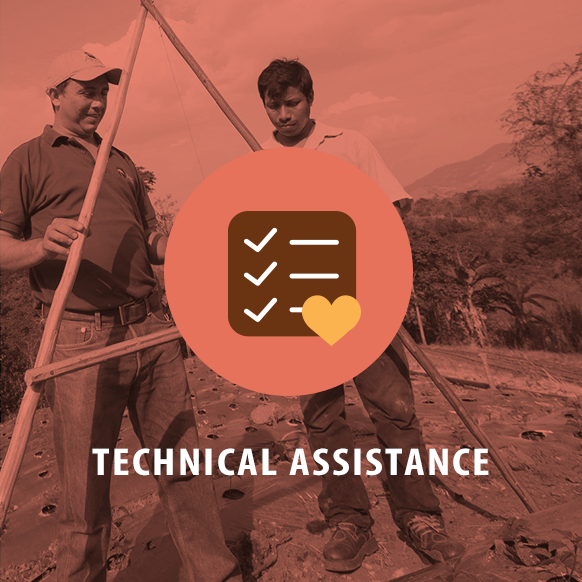5 WAYS FAMILIES WILL MAKE MORE MONEY (AND KEEP IT), THANKS TO YOU
You’ve heard us talk about Prosperity. That’s where our journey with families leads. But what does it look like when we arrive?
It’s an important question because – as the Cheshire Cat says to Alice – “If you don’t know where you’re going, any road will take you there.”
You have to define success in order to acheive it. And when you’re talking about promising to help a family escape generational poverty, the stakes are high.
MORE THAN $$$
Poverty, as you know, has many dimensions. A poor family lacks not only money, but also the skills and connections to bring in money. They’re likely to suffer from poor health, not only from lack of healthcare, but also from exposure to unclean water, a lack of essential vitamins and nutrients, unprotected physical labor, and violence. They may not have a permanent home, exacerbating everything, including their ability to believe and invest in their situation ever improving. The list, unfortunately, goes on …
So getting out of poverty takes more than money. That’s why the vertical axis on our Path to Prosperity graph below measures not just cash, but Resilience.
Resilience predicts how long a family’s current state will endure. If cash gets you to the high dive, resilience tells you how wide the platform is, so you don’t fall right back off. With only the skills and resources to make and manage money, a family stands on a narrow board. They need the stability of a home, access to basic services like clean water and sanitation, and connection to healthcare and education to gain secure footing where they are. Otherwise a shock like a sudden illness could send them tumbling right back down.

Our Path to Prosperity maps families’ progress from Extreme Poverty to Prosperity over time. The left axis measures increasing Resilience, which combines material well-being, i.e. money, housing, possessions, with elements that reduce the likelihood they’ll fall back into poverty if a shock occurs, like land titling & healthcare access, marketable skills, and civic connections.
7 DIMENSIONS OF PROSPERITY
We’ve created a new surveying tool that measures Prosperity for our rural families in seven different dimensions to capture the complexity of a resilient Prosperity. The seven dimensions are:
- Food security and nutrition: Assesses if and how often families don’t have enough to eat.
- Social infrastructure: Assesses access to sanitation, clean water, housing quality, and presence of safe stoves, sinks and latrines.
- Community health and gender equity: Assesses access to healthcare, disease prevalence, and equal participation of women in decision-making and leadership.
- Education: Assesses primary school attendance.
- Agricultural production: Assesses use of technical farming methods, crop diversity and farm productivity.
- Financial empowerment: Assesses income level, loan access, debt management, and savings.
- Access to land: Assesses how much families have repaid land loans.
How do these indicators work? And how do we move each one along? Because our work is holistic and longterm, we address them somewhat in concert and somewhat sequentially, from 1-7. We expect families to progress quickly in some and slowly in others. (Plus, this is a new evaluation system – so we’re learning and adjusting our expectations as we go.)
But there are reasonable assumptions we can make. You can’t teach a family complex coffee-growing techniques when they can’t feed themselves, for example. So we need to move the food security and nutrition indicator early on during our Recovery stage work with families.
Developing families’ capacities in agricultural production, on the other hand, should begin slowly during Recovery (by teaching families more effective methods to grow corn and beans), then ramp up significantly in Asset Growth when families are stable enough to focus their energy on building efficient, high-value, high-quality farms.
5 CONCRETE WAYS YOUR GIFTS ARE PUSHING FAMILIES CLOSER TO PROSPERITY
Families in Tierra Nueva, Bella Vista, Piedra de Horeb, Luz del Mañana, and San José have all crossed Asset Building (per our 2016 survey). And your support for the 2016-2017 Village Plans will push them past Asset Growth, putting Prosperity within every family’s grasp.
So what does this all look like for one family?
Many markers of progress you’ve already seen: dignified, cement-floored homes with well-vented kitchens (Indicator 2). Rural healthcare access through a system of trained volunteer brigadistas (Indicator 3). Kids in school (Indicator 4). These elements build our foundation for resilience.
Today, I want to share 5 concrete ways your gifts today are pushing families closer to Prosperity by the end of 2017. Because all 5 villages are in the later stages of their development, you’ll notice these are all economically-oriented, as we strive to tackle indicators 5, 6, and 7 above and ensure families prepare to leave Agros with businesses that generate consistent income.

Repayment of at least 30% of the family’s outstanding land loan
Building off of payments already made, this will put full land loan repayment within reach.

$800+ of new investments in productive assets
These investments in infrastructure, equipment, and high-value crops on families’ agricultural businesses will sustainably generate income for years to come.

The equivalent of 5-7 months wages at harvest time
Income from these new 2016-2017 crop cycles will generate cash on top of crops and businesses families already manage.

Permanent connections to established local markets
Guarantee they’ll have a formal buyer for future harvests at a market-rate price.

90+ hours of 1-on-1 technical agricultural training
Ensure farmers can repeat their results, efficiently producing high-quality products that profitable markets demand.
In case you’re wondering why I said families will be “within reach of Prosperity” as they achieve these results at the end of 2017, it’s because that’s our realistic assessment. Although Prosperity is the end point of our path for families, we don’t expect all families to attain it during their 8-year partnership with us. Most will get there later, propelled by the momentum of their successful businesses.
It’s worth noting as well that the 5 outcomes listed here assume that families haven’t quite reached Prosperity yet – but they’re out of poverty, without a doubt. And they clearly and measurably have the social, civic, and economic means to reach Prosperity and close the door on poverty forever.
Follow us on Social Media: Facebook | Instagram | LinkedIn | Twitter | YouTube
 Anna Lehn
Anna Lehn
Marketing & Communications Manager

